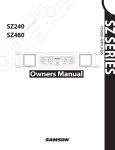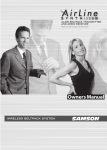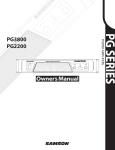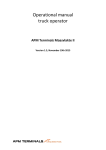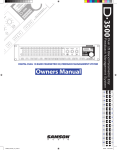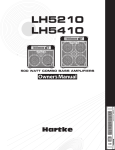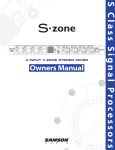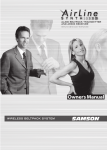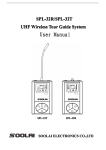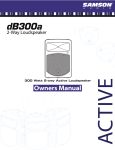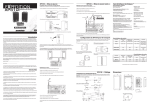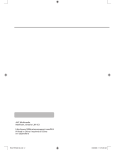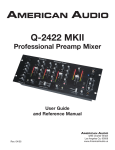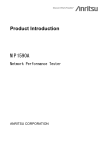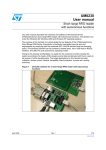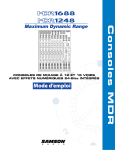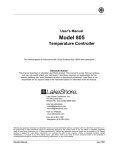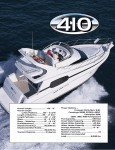Download ZM75 / ZM125 User Manual (English) PDF
Transcript
ZM125 ZM75 SAMSON +12 +3 +12dB 0 0 ZM125 0 dB -4 -10 -12 -12dB -20 125 WATT ZONE AMPLIFIER 125Hz MIN MAX MIN MAX MIN MAX MIN MAX MIN MAX MIN MAX MIN MAX ALL 250Hz ZONE 1 500Hz 1kHz ZONE 2 2kHz ZONE 3 4kHz ZONE 4 8kHz ZONE 5 ON OFF SAMSON +12 +3 +12dB 0 0 ZM75 0 dB -4 -10 -12 -12dB -20 75 WATT ZONE AMPLIFIER 125Hz MIN MAX MIN MAX MIN MAX MIN MAX MIN MAX MIN MAX MIN MAX ALL 250Hz ZONE 1 500Hz ZONE 2 1kHz 2kHz ZONE 3 4kHz ZONE 4 8kHz ZONE 5 ON OFF 7!2.).' 4/02%6%.4&)2%/23(/#+(!:!2$$/./453%4()30,5'7)4(!.%84%./.#/2$2%#%04!#,% /2/4(%2/54,%45.,%334(%",!$%3#!."%&5,,9).3%24%$4/02%3%.4",!$%%80/352% 4/02%6%.4&)2%/23(/#+(!:!2$$/./4%80/3%4()3!00,)!.#%4/2!)./2-/)3452% 4/026%.4%,%#42)#!,3(/#+-!4#(7)$%",!$%0,5'4/7)$%3,/4&5,,9).3%24 #!54)/. 2)3+/&%,%#42)#3(/#+ $/./4/0%. 4HISLIGHTNIGFLASHWITHARROW HEADSYMBOLWITHINANEQUI LATERALTRIANGLEISINTENDEDTO ALERTTHEUSERTOTHEPRESENCE OF UNINSULATED hDANGEROUS VOLTAGEv WITHIN THE PRODUCTS ENCLOSURE THAT MAY BE OF SUFFICIENT MAGNITUDE TO CONSTITUTE A RISK OF ELECTRIC SHOCKTOPERSONS 7ARNING4OREDUCETHERISKOF ELECTRIC SHOCK DO NOT REMOVE COVER OR BACK NO USER SERVICEABLEPARTSINSIDE2EFER SERVING TO QUALIFIED SERVICE PERSONNEL 4HEEXCLAMATIONPOINTWITHIN AN EQUILATERAL TRIANGLE IS INTENDEDTOALERTTHEUSERTO THE PRESENCE OF IMPORTANT OPERATING AND MAINTENANCE SERVICING INSTRUCTIONS IN THE LITERATURE ACCOMPANYING THEAPPLIANCE )-0/24!.43!&%49).3425#4)/.3 2EADTHESEINSTRUCTIONS +EEPTHESEINSTRUCTIONS (EEDALLWARNINGS &OLLOWALLINSTRUCTIONS $ONOTUSETHISAPPARATUSNEARWATER #LEANONLYWITHDRYCLOTH $ONOTBLOCKANYVENTIATIONOPENINGS)NSTALLINACCORDANCEWITHTHEMANUFACTURESINSTRUCTIONS $O NOT INSTALL NEAR ANY HEAT SOURCES SUCH AS RADIATORS HEAT REGISTERS STOVES OR OTHER APPARTUS INCLUDINGAMPLIFIERSTHARPRODUCEHEAT $O NOT DEFEAT THE SAFETY PURPOSE OF THE POLARIZED OR GROUNDING TYPE PLUG ! POLARIZED PLUG HAS TWO BLADESWITHONEWIDERTHANTHEOTHER!GROUNDINGTYPEPLUGHASTWOBLADESANDATHIRDGROUNDINGPRONG 4HEWIDEBLADEORTHETHIRDPRONGAREPROVIDEDFORYOURSAFETY)FTHEPROVIDEDPLUGDOESNOTFITINTOYOUR OUTLETCONSULTANELECTRICIANFORREPLACEMENTOFTHEOBSOLETEOUTLET 0ROTESTTHEPOWERCORDFROMBEINGWALKEDONORPINCHEDPARTICULARYATTHEPLUGSCONVENIENCERECEP TACLESANDATTHEPOINTWHERETHEYEXITFROMTHEAPPARATUS /NLYUSEATTACHMENTSACCESSORIESSPECIFIEDBYTHEMANUFACTURER 5SEONLYWITHTHECARTSTANDTRIPODBRACKETORTABLESPECIFIEDBYTHEMANUFAC TURER OR SOLD WITH THE APPARATUS 7HEN A CART IS USED USE CAUTION WHEN MOVINGTHECARTAPPARATUSCOMBINATIONTOAVOIDINJURYFROMTIPOVER 5NPLUGTHEAPPARATUSDURINGLIGHTENINGSORTORWHENUNUSEDFORLONGPERIODSOFTIME 2EFERALLSERVICINGTOQUALIFIEDPERSONNEL3ERVINGISREQUIREDWHENTHEAPPARATUSHASBEENDAMAGEDIN ANYWAYSUCHASPOWERSUPPLYCORDORPLUGISDAMAGEDLIQUIDHASBEENSPILLEDOROBJECTSHAVEFALLEN INTO THE APPARATUS HAS BEEN EXPOSED TO RAIN OR MOISTURE DOES NOT OPERATE NORMALLY OR HAS BEEN DROPPED 4HISAPPLIANCESHALLNOTBEEXPOSEDTODRIPPINGORSPLASHINGWATERANDTHATNOOBJECTFILLEDWITHLIQUID SUCHASVASESSHALLBEPLACEDONTHEAPPARATUS #AUTIONTOPREVENTELECRICALSHOCKMATCHWIDEBLADEPLUGWIDESLOTFULLYINSERT 0LEASEKEEPAGOODVENTILATIONENVIRONMENTAROUNDTHEENTIREUNIT Safety Instructions/Consignes de sécurité/Sicherheitsvorkehrungen/Instrucciones de seguridad WARNING: To reduce the risk of fire or electric shock, do not expose this unit to rain or moisture. To reduce the hazard of electrical shock, do not remove cover or back. No user serviceable parts inside. Please refer all servicing to qualified personnel.The lightning flash with an arrowhead symbol within an equilateral triangle, is intended to alert the user to the presence of uninsulated "dangerous voltage" within the products enclosure that may be of sufficient magnitude to constitute a risk of electric shock to persons. The exclamation point within an equilateral triangle is intended to alert the user to the presence of important operating and maintenance (servicing) instructions in the literature accompanying the product. Important Safety Instructions 1. Please read all instructions before operating the unit. 2. Keep these instructions for future reference. 3. Please heed all safety warnings. 4. Follow manufacturers instructions. 5. Do not use this unit near water or moisture. 6. Clean only with a damp cloth. 7.Do not block any of the ventilation openings. Install in accordance with the manufacturers instructions. 8. Do not install near any heat sources such as radiators, heat registers, stoves, or other apparatus (including amplifiers) that produce heat. 9. Do not defeat the safety purpose of the polarized or grounding-type plug. A polarized plug has two blades with one wider than the other. A grounding type plug has two blades and a third grounding prong. The wide blade or third prong is provided for your safety. When the provided plug does not fit your outlet, consult an electrician for replacement of the obsolete outlet. 10. Protect the power cord from being walked on and pinched particularly at plugs, convenience receptacles and at the point at which they exit from the unit. 11. Unplug this unit during lightning storms or when unused for long periods of time. 12.Refer all servicing to qualified personnel. Servicing is required when the unit has been damaged in any way, such as power supply cord or plug damage, or if liquid has been spilled or objects have fallen into the unit, the unit has been exposed to rain or moisture, does not operate normally, or has been dropped. ATTENTION: Pour éviter tout risque d’électrocution ou d’incendie, ne pas exposer cet appareil à la pluie ou à l’humidité. Pour éviter tout risque d’électrocution, ne pas ôter le couvercle ou le dos du boîtier. Cet appareil ne contient aucune pièce remplaçable par l'utilisateur. Confiez toutes les réparations à un personnel qualifié. Le signe avec un éclair dans un triangle prévient l’utilisateur de la présence d’une tension dangereuse et non isolée dans l’appareil. Cette tension constitue un risque d’électrocution. Le signe avec un point d’exclamation dans un triangle prévient l’utilisateur d’instructions importantes relatives à l’utilisation et à la maintenance du produit. Consignes de sécurité importantes 1. Veuillez lire toutes les instructions avant d’utiliser l’appareil. 2. Conserver ces instructions pour toute lecture ultérieure. 3. Lisez avec attention toutes les consignes de sécurité. 4. Suivez les instructions du fabricant. 5.Ne pas utiliser cet appareil près d’une source liquide ou dans un lieu humide. 6. Nettoyez l’appareil uniquement avec un tissu humide. 7.Veillez à ne pas obstruer les fentes prévues pour la ventilation de l’appareil. Installez l’appareil selon les instructions du fabricant. 8. Ne pas installer près d’une source de chaleur (radiateurs, etc.) ou de tout équipement susceptible de générer de la chaleur (amplificateurs de puissance par exemple). 9. Ne pas retirer la terre du cordon secteur ou de la prise murale. Les fiches canadiennes avec polarisation (avec une lame plus large) ne doivent pas être modifiées. Si votre prise murale ne correspond pas au modèle fourni, consultez votre électricien. 10. Protégez le cordon secteur contre tous les dommages possibles (pincement, tension, torsion,, etc.). Veillez à ce que le cordon secteur soit libre, en particulier à sa sortie du boîtier. 11. Déconnectez l’appareil du secteur en présence d’orage ou lors de périodes d’inutilisation prolongées. 12.Consultez un service de réparation qualifié pour tout dysfonctionnement (dommage sur le cordon secteur, baisse de performances, exposition à la pluie, projection liquide dans l’appareil, introduction d’un objet dans le boîtier, etc.). ACHTUNG: Um die Gefahr eines Brandes oder Stromschlags zu verringern, sollten Sie dieses Gerät weder Regen noch Feuchtigkeit aussetzen.Um die Gefahr eines Stromschlags zu verringern, sollten Sie weder Deckel noch Rückwand des Geräts entfernen. Im Innern befinden sich keine Teile, die vom Anwender gewartet werden können. Überlassen Sie die Wartung qualifiziertem Fachpersonal.Der Blitz mit Pfeilspitze im gleichseitigen Dreieck soll den Anwender vor nichtisolierter “gefährlicher Spannung” im Geräteinnern warnen. Diese Spannung kann so hoch sein, dass die Gefahr eines Stromschlags besteht. Das Ausrufezeichen im gleichseitigen Dreieck soll den Anwender auf wichtige Bedienungs- und Wartungsanleitungen aufmerksam machen, die im mitgelieferten Informationsmaterial näher beschrieben werden. Wichtige Sicherheitsvorkehrungen 1. Lesen Sie alle Anleitungen, bevor Sie das Gerät in Betrieb nehmen. 2. Bewahren Sie diese Anleitungen für den späteren Gebrauch gut auf. 3. Bitte treffen Sie alle beschriebenen Sicherheitsvorkehrungen. 4. Befolgen Sie die Anleitungen des Herstellers. 5. Benutzen Sie das Gerät nicht in der Nähe von Wasser oder Feuchtigkeit. 6. Verwenden Sie zur Reinigung des Geräts nur ein feuchtes Tuch. 7.Blockieren Sie keine Belüftungsöffnungen. Nehmen Sie den Einbau des Geräts nur entsprechend den Anweisungen des Herstellers vor. 8. Bauen Sie das Gerät nicht in der Nähe von Wärmequellen wie Heizkörpern, Wärmeklappen, Öfen oder anderen Geräten (inklusive Verstärkern) ein, die Hitze erzeugen. 9. Setzen Sie die Sicherheitsfunktion des polarisierten oder geerdeten Steckers nicht außer Kraft. Ein polarisierter Stecker hat zwei flache, unterschiedlich breite Pole. Ein geerdeter Stecker hat zwei flache Pole und einen dritten Erdungsstift. Der breitere Pol oder der dritte Stift dient Ihrer Sicherheit. Wenn der vorhandene Stecker nicht in Ihre Steckdose passt, lassen Sie die veraltete Steckdose von einem Elektriker ersetzen. 10. Schützen Sie das Netzkabel dahingehend, dass niemand darüber laufen und es nicht geknickt werden kann. Achten Sie hierbei besonders auf Netzstecker, Mehrfachsteckdosen und den Kabelanschluss am Gerät. 11. Ziehen Sie den Netzstecker des Geräts bei Gewittern oder längeren Betriebspausen aus der Steckdose. 12.Überlassen Sie die Wartung qualifiziertem Fachpersonal. Eine Wartung ist notwendig, wenn das Gerät auf irgendeine Weise, beispielsweise am Kabel oder Netzstecker beschädigt wurde, oder wenn Flüssigkeiten oder Objekte in das Gerät gelangt sind, es Regen oder Feuchtigkeit ausgesetzt war, nicht mehr wie gewohnt betrieben werden kann oder fallen gelassen wurde. PRECAUCION: Para reducir el riesgo de incendios o descargas, no permita que este aparato quede expuesto a la lluvia o la humedad. Para reducir el riesgo de descarga eléctrica, nunca quite la tapa ni el chasis. Dentro del aparato no hay piezas susceptibles de ser reparadas por el usuario. Dirija cualquier reparación al servicio técnico oficial. El símbolo del relámpago dentro del triángulo equilátero pretende advertir al usuario de la presencia de “voltajes peligrosos” no aislados dentro de la carcasa del producto, que pueden ser de la magnitud suficiente como para constituir un riesgo de descarga eléctrica a las personas. El símbolo de exclamación dentro del triángulo equilátero quiere advertirle de la existencia de importantes instrucciones de manejo y mantenimiento (reparaciones) en los documentos que se adjuntan con este aparato. Instrucciones importantes de seguridad 1. Lea todo este manual de instrucciones antes de comenzar a usar la unidad. 2. Conserve estas instrucciones para cualquier consulta en el futuro. 3. Cumpla con todo lo indicado en las precauciones de seguridad. 4. Observe y siga todas las instrucciones del fabricante. 5. Nunca utilice este aparato cerca del agua o en lugares húmedos. 6. Limpie este aparato solo con un trapo suave y ligeramente humedecido. 7.No bloquee ninguna de las aberturas de ventilación. Instale este aparato de acuerdo a las instrucciones del fabricante. 8. No instale este aparato cerca de fuentes de calor como radiadores, calentadores, hornos u otros aparatos (incluyendo amplificadores) que produzcan calor. 9. No anule el sistema de seguridad del enchufe de tipo polarizado o con toma de tierra. Un enchufe polarizado tiene dos bornes, uno más ancho que el otro. Uno con toma de tierra tiene dos bornes normales y un tercero para la conexión a tierra. El borne ancho o el tercero se incluyen como medida de seguridad. Cuando el enchufe no encaje en su salida de corriente, llame a un electricista para que le cambie su salida anticuada. 10. Evite que el cable de corriente quede en una posición en la que pueda ser pisado o aplastado, especialmente en los enchufes, receptáculos y en el punto en el que salen de la unidad. 11. Desconecte de la corriente este aparato durante las tormentas eléctricas o cuando no lo vaya a usar durante un periodo de tiempo largo. 12. Dirija cualquier posible reparación solo al servicio técnico oficial. Deberá hacer que su aparato sea reparado cuando esté dañado de alguna forma, como si el cable de corriente o el enchufe están dañados, o si se han derramado líquidos o se ha introducido algún objeto dentro de la unidad, si esta ha quedado expuesta a la lluvia o la humedad, si no funciona normalmente o si ha caído al suelo. Table of Contents Introduction. . . . . . . . . . . . . . . . . . . . . . . . . . . . . . . . . . . . . . . . . . . . . . . . . . . . . . . . . . . . . . . . . . . . . 1 ZM Series Features. . . . . . . . . . . . . . . . . . . . . . . . . . . . . . . . . . . . . . . . . . . . . . . . . . . . . . . . . . . . . . . 2 ZM Series Layout - Front Panel. . . . . . . . . . . . . . . . . . . . . . . . . . . . . . . . . . . . . . . . . . . . . . . . . . . . 3 ZM Series Layout - Rear Panel. . . . . . . . . . . . . . . . . . . . . . . . . . . . . . . . . . . . . . . . . . . . . . . . . . . . . 4 Designing an Installation Plan. . . . . . . . . . . . . . . . . . . . . . . . . . . . . . . . . . . . . . . . . . . . . . . . . . . . 5 Operating The ZM Series. . . . . . . . . . . . . . . . . . . . . . . . . . . . . . . . . . . . . . . . . . . . . . . . . . . . . . . . . 8 Operating The ZM Series. . . . . . . . . . . . . . . . . . . . . . . . . . . . . . . . . . . . . . . . . . . . . . . . . . . . . . . . . 9 Operating The ZM Series. . . . . . . . . . . . . . . . . . . . . . . . . . . . . . . . . . . . . . . . . . . . . . . . . . . . . . . . 10 ZM Series System Set Up. . . . . . . . . . . . . . . . . . . . . . . . . . . . . . . . . . . . . . . . . . . . . . . . . . . . . . . . 11 ZM Series Input Wiring Guide. . . . . . . . . . . . . . . . . . . . . . . . . . . . . . . . . . . . . . . . . . . . . . . . . . . . 12 ZM Series Output Wiring Guide. . . . . . . . . . . . . . . . . . . . . . . . . . . . . . . . . . . . . . . . . . . . . . . . . . 13 Specifications. . . . . . . . . . . . . . . . . . . . . . . . . . . . . . . . . . . . . . . . . . . . . . . . . . . . . . . . . . . . . . . . . . . 14 Block Diagram. . . . . . . . . . . . . . . . . . . . . . . . . . . . . . . . . . . . . . . . . . . . . . . . . . . . . . . . . . . . . . . . . . 15 Copyright 2007 Printed December, 2007 v1.0 Samson Technologies Corp. 45 Gilpin Avenue Hauppauge, New York 11788-8816 Phone: 1-800-3-SAMSON (1-800-372-6766) Fax: 631-784-2201 www.samsontech.com Introduction Thank you for purchasing the ZM series mixer/amplifier from Samson Technologies! The ZM series mixers provide an ideal solution for small to medium size commercial sound system installations. This manual covers two models: the ZM75 and the ZM125. Both ZM series models feature a built in constant voltage power amplifier capable of running at 25, 70 or 100 volts or at low impedance 4-ohm operation. The ZM75 provides 75 watts, while the ZM125 provides 125 watts of clean power. Six input channels with individual level controls are provided so connecting sound sources is simple thanks to the available XLR, 1/4-inch and RCA connectors. In addition, both models feature five selectable speaker Zone outputs. The ZM75 and ZM125 are ideal for distributing music and announcements throughout different rooms in an installation and the dedicated paging microphone input allows you to setup a distant paging station (for a hostess in the restaurant, for example). There’s even an onboard Chime, with four selectable tones, to alert the listeners of an upcoming page. For businesses that want to improve their customers telephone experience, a MOH (Music on Hold) facility is also included. When interfaced with a business telecom system, music or valuable prerecorded announcements are heard while customers are on Hold. To control the overall tonal response of the sound system, the ZM series employ a seven-band graphic equalizer. A Master level control and five segment level meters allow you to set a clean signal at the correct volume. For added flexibility you can add the optional Samson TCM-3 sound module with FM tuner and CD player that can play MP3 recordings. The ZM75 and ZM125 can be table-top or mounted in a standard 19-inch equipment rack using the included rack mount ears. The sleek black finish matches just about any décor, plus the steel chassis adds to it durability and reliability. Perfect for schools, restaurants, office buildings, small factories, or just about any place good quality, distributed sound is needed, the ZM75 and ZM125 offer excellent sound and great value. In this manual, you’ll find a detailed description of the features of the ZM Series Amplifiers, as well as a guided tour through the front and rear panels, step-by-step instructions for using the unit, suggested applications and full specifications. You’ll also find a warranty card enclosed—please don’t forget to fill it out and mail it so that you can receive online technical support and so we can send you updated information about other Samson products in the future. Also, be sure to check out our website (www.samsontech.com) for complete information about our full line of Samson audio products. With proper care and adequate air circulation, your ZM Series amplifer will operate trouble free for many years. We recommend you record your serial number in the space provided below for future reference. Serial number: _______________________________ Date of purchase: _____________________________ Should your unit ever require servicing, a Return Authorization number (RA) must be obtained before shipping your unit to Samson. Without this number, the unit will not be accepted. Please call Samson at 1-8003SAMSON (1-800-372-6766) for a Return Authorization number prior to shipping your unit. Please retain the original packing materials and if possible, return the unit in the original carton and packing materials. If you purchased your Samson product outside the United States, please contact your local distributor for warranty information and service. ZM Series Features SAMSON +12 +3 +12dB 0 0 ZM125 0 dB -4 -10 -12 -12dB -20 125 WATT ZONE AMPLIFIER 125Hz MIN MAX MIN MAX MIN MAX MIN MAX MIN MAX MIN MAX MIN MAX ALL 250Hz ZONE 1 500Hz ZONE 2 1kHz 2kHz ZONE 3 4kHz ZONE 4 8kHz ZONE 5 ON OFF The ZM75 and ZM125 powered zone mixers are perfect for small to medium size commercial sound system installations. Here are some of their main features: • Phantom power is supplied on Mic channels 1 and 2 for connecting condenser microphones. • To insure long-term reliability, the ZM series feature advanced amplifier protection including current limiting, over current and thermal protection. • Connecting sound sources is easy thanks to the six mic/line inputs on 1/4-inch XLR and RCA connectors, which accommodate a wide range of audio devices' input levels. • ZM systems can be expanded with an external mixer or power amplifier using their LINK and Preamp terminals. • The ZM series provide plenty of available power, with 75 watts ZM75 and 125 watts for the ZM125. • The ZM series features advanced electric circuit design with high quality op-amps providing low distortion and low noise. • A built-in seven-band graphic equalizer is included to adjust the sound system’s overall tonal response. • Setting up the ZM series amplifiers is easy as the compact units can be configured for table-top or for standard19-inch rack mount installation. • The ZM75 and ZM125 have an intelligent, three layer priority muting system ensuring important announcements are heard throughout the entire installation. • Ideal solution for commercial sound and industrial applications. • The ZM series feature a remote microphone connection on a convenient Euroblock terminal to control the mute. • Expansion bay for adding optional Samson TCM3 music source module. • Extended three-year warranty. • For paging, the ZM series feature a built-in announcement Chime with four selectable tones. • M.O.H. (Music On Hold) input and output allows you to connect a music source or pre-recorded announcement to your telephone system. • A convenient telephone paging input on a Euroblock terminal allows you to interface your PBX system for handset paging. ZM Series Layout - Front Panel 1 2 3 4 SAMSON +12 +12dB +3 0 dB -4 5 0 0 ZM125 -10 -12 -12dB -20 125 WATT ZONE AMPLIFIER 125Hz MIN MAX MIN MAX MIN MAX MIN MAX MIN MAX MIN MAX MIN MAX ALL 250Hz ZONE 1 500Hz 1kHz ZONE 2 2kHz ZONE 3 4kHz ZONE 4 8kHz ZONE 5 ON OFF 6 7 1. EXPANSION BAY – You can add background music or pre-recorded announcements by installing the optional Samson TCM-3 CD and MP3 player with AM/FM tuner module in this compartment. 8 9 10 11 8. CHIME (switch) – When pressed, the ZM series will play a selectable Chime to used as a "preannouncement" for paging. 9. ALL (switch) - Used to simultaneously assign the input sources to each of the speaker zone outputs. 2. GRAPHIC EQUALIZER - Used to control the overall system frequency response with filters at 125Hz, 250Hz, 500Hz, 1kHz, 2kHz, 4kHz and 8kHz with12dB of cut or boost. 10.ZONE 1 - 5 (output switches) - Used to assign the input sources to the individual speaker zone outputs. 3. PROTECT (LED indicator) – When illuminated, the unit is in Protect mode and the outputs will be muted. 11.POWER (switch) - Use this to power the ZM75 and ZM125 on or off. The POWER LED lights whenever the ZM series is powered on. 4.OUTPUT LEVEL (LED indicators) – This five segment LED bar meter display the system output level. 5. POWER (LED indicator) – When illuminated, the unit is powered up and ready for operation. 6. LEVEL (control knob) – The six control knobs are used to set the individual level of the input sources. 7. MASTER (control knob) – This control knob adjusts the overall system volume. ZM Series Layout - Rear Panel 1 2 3 OUTPUT COM Constant Voltage 100V/70V/25V Lo-Z FM 75 4 5 300 MUSIC ON HOLD CHIME MAX MIN VOLUME PRE-AMP OUT SAMSON 230 V 115 V ZM125 125 WATT ZONE AMPLIFIER 8 AMP IN MIN FUSE T2AL/250V 7 6 AVIS RISQUE DE CHOC ELECTRONIQUE NE PAS OUVRIR CAUTION FOR CONTINUED PROTECTION AGAINST RISK OF FIRE, REPLACE ONLY SAME TYPE FUSE ATTENTION UTILISER UN FUSIBLE DE RECHANGE MEME TYPE -6/+14 -50/-30 -6/+14 GAIN -50/-30 GAIN -6 -50 -6 GAIN -50 -6 GAIN -50 INT. REMOTE MIC G LINE/ EXT. MOH LINE ON ON OFF ON MIC MIN H C H G OFF PHANTOM MIC MIC MAX GAIN TELE-PAGING MIC OFF PRIORITY PHANTOM LINK IN -50 GAIN OFF PRIORITY EXT. C -6 GAIN ON H WARNING DO NOT EXPOSE THIS EQUIPMENT TO RAIN OR MOISTURE MAX VOLUME C MIC MIC G SW LINK OUT 115Vac/230Vac 50Hz/60Hz, 167W 19 18 17 16 15 14 13 12 11 10 9 1-25V, 70V and 100V (output connector) - Tencontact Euroblock connector for connecting the 25V, 70V and 100V constant voltage outputs. 11 - MIC INPUTS (connectors) – Channels 3 and 4 are microphone level inputs on standard XLR connectors. 2 - LO-Z (output connector) - Two-contact Euroblock connector for connecting the 4-Ohm speaker output. 12 -MIC/LINE INPUTS (connectors) – Input channels 5 and 6 feature 1/4-inch and RCA connectors for mic or line level input signals. 3 - AMP IN and PRE-AMP OUT (connectors) – These 1/4-inch phone jacks are used to connect an external effect processor. 13 -REMOTE MIC input connector – Connect the paging microphone to this four-contact Euroblock connector. 4 - MOH VOLUME (control knob) –This control knob allows you to adjust the level of the Music on Hold sound source. 14 -REMOTE MIC GAIN (control knob) – This trim control is used to set the input sensitivity for the remote microphone input. 5 - MOH (selection switch) – The slide switch is used to chose the Music on Hold sound source from the output of the internal mixer or an external sound source (like a CD or MP3 player). 15 -TELE PAGING (connector) – This three-contact Euroblock connector is used to connect the ZM series to a business telecom system so that pages can be made from any handset. 6 -CHIME VOLUME - (control knob) – The control knob is used to adjust the level of the Chime tone. 16 - MOH OUTPUT (connector) - This three-contact Euroblock connector is used to attach an external sound source for the Music on Hold system. 7 -GAIN (control knobs) – The trim knobs are used to set the input sensitivity for each input channel. 17 - LINK IN and LINK OUT (connectors) - Use these connectors to expand your system by adding a second ZM series mixer/amplifier. 8 -PRIORITY MIC (switch) – When set to on, this slide switch configures mic channels 1 and/or 2 to mute the other input channels when a signal is present on the connected microphones. 18 -VOLTAGE SELECTION (switch) - Used to select the operation voltage for either 115 or 230 Volts. Be sure to check the correct operating voltage for your particular country. 9 -PHANTOM POWER (switch) – Used this slide switch to activate the phantom power on mic channels 1 and/or 2. 19 -AC INLET – Connect the supplied IEC power cable here. 10 - MIC/LINE INPUTS (connectors) – Channels 1 and 2 employ combination connectors with XLR and 1/4-inch inputs, which can accept either mic or line signals. Designing an Installation Plan Designing an Installation Plan If you are a professional installer, you’ll probably want to skip over this section, however if you are setting up your system for the first time, this section can help make your installation a little bit easier. Before you start plugging, stripping and connecting wires, it is a good idea to have a clear installation plan. To create your installation plan, you need to consider several design parameters including what sound sources will be used, if announcement paging in necessary, which rooms need to have sound, if a remote paging mic is required, which type of speakers will do the best job for the room they are covering, and your wiring plan. Selecting the Sound Sources If you are using multiple sound sources, you'll need some type of mixer and for fixed installations, a zone mixer like the Samson ZM series is ideal. The ZM series provides six input channels with the ability to connect up to six input sources. On input Channel’s 1 and 2 there is an input for connecting microphones with phantom power to operate condenser type mics. The ZM series also has a special priority feature so when you speak on the microphone, the music is automatically muted. You can connect line level signals on four input channels, so signals from TAPE, CD, DVD or Karaoke players, Audio/Video TV monitors, Radio Tuners, DJ mixers or any other line level device can be used as a sound source. You may also be able to connect the output from a Home Hi-fi receiver if it’s equipped with a line level output. Creating the Audio Zones You can create separate audio environments using up to five ZM series’s outputs, each connected to an input channel on the ZM75 or ZM125 amplifier. You can connect one or more speakers with a total load impedance of 4 ohms or more to each output of the ZM Series amplifier. Obviously, (or perhaps not so obviously) we call an output a zone on the ZM series, but a zone is also the area where you want to have sound. So, think about where you want to distribute the sound. The ZM series can accomplish all of this easily. In addition, the ZM series let’s you easily connect a remote microphone for paging. 1 2 3 4 5 6 7 8 9 * 0 # Designing an Installation Plan Now, take some time to consider where you need to have sound in your particular installation. After you have decided where you need to create sound zones, you can consider your speaker selection, but first decide where you are going to locate your equipment rack. Using Passive Speakers If you are using passive (un-powered) speakers, you need to first decide where you will place your ZM series mixer/amplifier. If the speakers in a particular sound zone are less than 100 feet away, connect the wires from the amplifier to your passive speakers directly. Locating Your Equipment Rack Since the ZM Series amplifiers and ZM series are standard 19-inch rack mount devices, you should consider using an equipment rack, such as one of the Samson SRK series. To select a good location for your equipment rack, you should consider several points including the proximity to each of the sound zones, if the users need to access the gear to change CD’s or to adjust a volume level and if you have a convenient location to the electrical service, to name a few. You will need to consider the length of wire runs and routing necessary to make the connections from the equipment rack to the various sound zones. Depending on the speakers you choose, and the length of cable runs you need to make, you may choose to run speaker level or line level to the sound zones. If you are using passive (non-powered) speakers, you will need to connect the output channels of the ZM series to an input channel of the ZM Series amplifier and run speaker wire. However, you need to be careful to pay attention to the wire gauge and total length of the wire run. If you are using powered (active) speakers you can run long distances using the balanced outputs directly from the ZM series. Since the ZM series's output connections are terminated using Euroblock connectors, the wiring can easily be run in advance of the equipment installation. NOTE: This type of wiring is known as "home-run wiring" since you are making a direct connection from the amplifiers in the equipment rack to the speakers located in the sound zone room. Be sure to check the impedance of the speakers you are using. The ZM Series amplifiers can run at 4 ohms, so connect one 4 ohm or two 8 ohm speakers on the ZM Series 4-Ohm output. If the speakers in a particular sound zone are further than 100 feet, you should consider placing the amplifier in the same room as the sound zone or use a constant voltage speaker system. Using A Constant Voltage Speaker System If your installation requires multiple speakers and long cable runs you should consider running a 70 volt, constant voltage system. Constant voltage systems became the installation standard in the mid-1900’s offering a cost effective solution for installations using multiple speakers and long cable runs. The idea was borrowed from the cross-country power grid where voltage is stepped up and therefore the current is reduced allowing huge amounts of power to run over long distances on relatively small, lower cost cable. Ultimately the voltage is stepped down and delivered to the customer over a short, heavy gauge cable. Another type of installation is one that uses speakers and amplifiers (like the ZM Series) with 70-volt transformers, which are commonly referred to as Constant Voltage systems. The benefit of a constant voltage system is you can run long lengths of wire and have many speakers connected to a single amplifier. You can also balance the level of each speaker by using one of the available transformer settings. The ZM series mixer/amplifiers are ideal for this thanks to their built-in 25/70/100 volt output transformers. Selecting Speakers for Each Zone To select the speakers, you need to consider a few important issues like where you are going to place your power amplifiers, using powered or un-powered speakers, or if you need to run a 70-volt distributed sound system. The following sections provide a brief overview on how to connect active and passive speakers or a constant voltage system in a typical installation. Designing an Installation Plan Using A Constant Voltage Speaker System - continued The same principle is applied in constant voltage audio systems where a transformer is connected to the amplifier’s output to step up the voltage while lowering the output current, which allows you to use long runs of smaller gauge wire to connect to a series of speakers with step down transformers. For further cost savings, the 70 volt standard was adopted in the US since UL requires the use of conduit on lines over 100 volts peak. In addition to 70 volt operation, the ZM Series amplifiers can also operate 100 volt systems which is a standard in Europe. Commercial sound systems, like those installed in schools, office buildings and restaurants, commonly make use of constant voltage distributed sound systems when a large number of ceiling speakers are used to cover several different sound zones. Another example is connecting four of the Samson dB300i with the transformers wired for 25 watts to each channel of the ZM Series amplifier. Following the wiring diagram on the rear of the dB300i, connect the ground to Common, the Hot lead to 70 volt input, and finally, run a jumper from 8 ohms to the 25 watt connection as shown in the diagram below. Set up each of the dB300i they same way so that the four connected speakers equal 100 watts. Today, there are a large number of installation speakers available from various manufacturers that include onboard transformers for constant voltage systems. Many of these models, like the Samson dB300i, include selectable power taps on the transformer allowing you to distribute the power efficiently through the number of installed speakers and also adjust some speakers to different output levels. The ZM Series amplifiers have built in transformers on each channel that step up the output voltage and reduce the current allowing you to connect to a series of speakers with step down transformers over long cable runs. Constant voltage systems can use 14 to 18 gauge wire, while smaller gauge (larger diameter) cable should be used for longer runs. The dB300i's rear panel is configured for 70 volt 25 watt operation. A simple way to think about using constant voltage is to divide the total watts available by the number of speakers you want to use. You could also add up the speaker's step up transformer wattage to equal 100 watts or less. For example, if you want to use ten ceiling speakers on one channel of the ZM Series amplifier, use a ceiling speaker with a 12-watt transformer tap (120 watts divided by 10 speakers equals 12-watts per speaker). Now connect the four speakers to each of the ZM125's output as shown in the diagram below. Typical ceiling speaker with onboard transformer and six power taps. These power taps also control volume level for sound balancing. Operating The ZM Series Setting up the ZM series Setting up your ZM Series is a simple procedure, which takes only a few minutes: For 70-volt operation, connect the positive input of the speaker to the 70 Volt terminals and connect the negative input the COM (ground) terminal. Remove all packing materials (save them in case of need for future service) and decide where the amplifier is to be physically placed—it can be used table-top or mounted in a standard 19” rack (like the SRK equipment racks from Samson), requiring only two rack spaces. OUTPUT Install the rack ears by aligning them to the side of the unit, flush to the front and install the supplied screws. Be careful not to cross thread the screws. Then, remove the feet to allow the unit to fit the 2 rack spaces. When installed, make sure that both the front and rear panels are unobstructed and that there is good ventilation around the entire unit (we recommend the use of spacer panels, especially if multiple amplifiers are used in a rack. OUTPUT Constant Voltage 100V/70V/25V Lo-Z + - - + + Connecting the Speakers to the ZM Amplifier Make the speaker connections, using the Euroblock output connectors on the rear panel. It is never a good idea to power up any amplifier that is not connected to loudspeakers. When operating using the 4-ohm output, any loudspeakers with a minimum impedance load of 4 ohms (that is, 4 ohms or greater) can be used. COM Constant Voltage 100V/70V/25V COM Matching transformer + + The constant voltage output is set for either 70 or 100 Volts depending on the country, however if can be changed by reconfiguring the internal transformer wires. Locate the T10, T11, T12 and T13 terminals as per the diagram below. Lo-Z + 4Ω Now follow the wiring chart below to select the required operating voltage for constant voltage output. OR 8Ω + + - 8Ω Operating The ZM Series Pre Announcement Chime The ZM series mixer offers a useful Chime function to alert listeners of an upcoming page. Simply press the front panel Chime switch to play the chime. Connecting the Input Sources Next, make the signal input connections, using the Euroblock input connectors on the rear panel. If your mixer has balanced outputs, we recommend the use of three-conductor cabling and connectors (unbalanced two-conductor connections can also be used, but you’ll get better signal quality and less outside noise and hum if you use balanced lines). On the front panel of the ZM Series, turn all the Channel input controls fully counterclockwise (to their “MIN” setting). Then connect the supplied heavy-gauge 3-pin “IEC” cable to the rear panel IEC connector and to any grounded AC socket. Press the front panel Power switch in order to turn on the ZM Series. The Power LED will light and the Protection LED will go on. After approximately five seconds, the Protection LED will go off (you’ll hear a click when this occurs). In addition, the ZM series mixer can be set for one of four selectable Chime tones by moving the internal shorting jumpers as show in the figure below: CD Player Microphones Apply an input signal to the ZM Series at or about +4dBu. Now set the channel level to about half way up. Priority Control Channel 1 and 2 can be set for Priority operation. When microphone channel 1 and 2’s Priority switch is set to the “ON” position, the other input channels will mute whenever signal is present on the microphones connected to Channel 1 and 2. ON PRIORITY While the input signal is present, slowly raise the Master level control until the desired sound level is achieved. The SIGNAL and PEAK LED indicators will show you the MIN OFF Priority Mic Muting In addition to the priority muting on microphones connected to Channels 1 and 2, there are three levels of priority muting which is always active. The priority muting is set in three groups in the following order. Chime and Tele page Remote Mic Channels 1 through 6 MAX continuous power output of the ZM Series as signal is being passed. For the best signal-to-noise ratio, the ZM Series should normally be run with the Master level control at or near maximum (fully clockwise, at the “MAX” position) and the PEAK segments should light occasionally (but not frequently) during peak levels. If the signal is too loud, use the Input level controls attenuate the signals as necessary to achieve the desired speaker level. This means if there is a Tele-page or the Chime switch is pressed, the Remote Mic and input Channels 1 through 6 are muted. If there is a signal on the Remote Mic, Channel 1 through 6 will be muted. The signals in the same priority group will stay on together. Operating The ZM Series Using Music On Hold The ZM series include a MOH (Music On Hold) function allowing you to connect the ZM series to a business telephone system. With MOH, when customers call in to the business and are put on hold, they hear background music from an external source or from the internal source if the optional TCM-3 tuner/CD player is installed. You can make the call-in experience more pleasant or take advantage of valuable time by playing a pre-recorded commercial message using MOH. signal processor like dynamics (like the Samson S com plus), equalizer (like the Samson D2500 digital equalizer) or feedback management systems (like the Samson D3500). Connect the PRE-AMP OUT to the input of the signal processor. Then, connect the output of the signal processor to the AMP IN to complete the circuit. INPUT OUTPUT EFFECTS PROCESSOR 1 2 3 4 5 6 7 8 9 * 0 # Expanding The ZM system using LINK IN / LINK OUT If the system installation requires more inputs and outputs, you can use an external mixer or additional ZM series mixer/ amplifiers using the LINK IN and LINK OUT connectors. Connect the LINK out of the first ZM mixer/amp to the LINK in of the second. You can set the volume of the MOH signal using the MOH Level control. Using the TELE-Paging function You can connect the ZM75 and ZM 125 to a business telephone system using the TELE PAGING CONNECTOR allowing announcement paging from any telephone. Usually, the telephone system provides a dedicated output and has the ability to send a page using a certain extension number. Check the manufacturer's operating manual of the telephone system for operation detail. Using The Graphic Equalizer The ZM75 and ZM125 feature an onboard seven-band equalizer for adjusting the systems overall frequency response. The Equalizer includes seven filters, providing 12 dB of cut and boost at 125Hz, 250Hz, 500Hz, 1kHz, 2kHz, 4kHz and 8kHz. You can use the equalizer to contour the system response for music or speech. The Graphic EQ can also be useful for removing feedback. If feedback occurs, try lowering the mid range frequencies 1k and 2K. +12 +12dB 0 1 2 3 4 5 6 7 8 9 * 0 # 0 dB -12 -12dB 125Hz 250Hz 500Hz 1kHz 2kHz 4kHz 8kHz If you encounter difficulty with any aspect of setting up or using your ZM Series, contact your local Samson dealer. If purchased in the United States, you can call Samson Technical Support (1-800-372-6766) between 9 AM and 5 PM EST. Using External Effects AMP IN and PRE-AMP OUT The ZM series provides a convenient patch point between the mixer and power amp allowing you to connect an external 10 ZM Series System Set Up The following is a typical constant voltage system setup for a small restaurant using the ZM125 mixer/amplifier feeding several audio zones with paging and music. The first two ZM Series constant voltage outputs are connected to two ceiling speakers in each of the Dining Rooms with their transformers set to a 12 watt tap. The third constant voltage output powers two speakers in the outside Bar area with their transformers set to 25 watt. (The db300i's are specially treated so they're suitable for indoor and outdoor use.) The fourth ZM Series amp channel powers small speakers in the lobby with a 12 watt tap. 1 2 3 4 5 6 7 8 9 * 0 # 11 ZM Series Input Wiring Guide ZM Series Input Wiring Guide There are several ways to interface the ZM Series amplifers, depending on your exact system set-up. Follow the cable diagrams below for connecting to the input of your amplifier. Male XLR to Female XLR (balanced) Hot (2) Common (1) 1 2 3 End View 2 Common Hot Hot Common (1) Hot (2) Common 1 1 3 2 2 3 Solder Points Cold (3) Cold Male XLR Solder Points Cold 1 3 End View Cold (3) Female XLR Male XLR to 1/4-inch (Balanced) Male XLR to1/4-inch (Unbalanced) Tip (signal) Hot (2) Common (1) 1 2 3 End View 2 Signal Tip (signal) 1 3 Cold (Pin 3) (no connection) Solder Points Cold (3) Ground Male XLR Sleeve (ground) Sleeve (ground) Male XLR to RCA (Unbalanced) Tip (signal) Hot (2) Common (1) 1 2 3 End View 2 Tip (signal) 1 3 Solder Points Cold (3) Cold (Pin 3) (no connection) Sleeve (ground) Male XLR Sleeve (ground) 12 ZM Series Output Wiring Guide ZM Series Output Wiring Guide There are several ways to interface the ZM Series amplifers, depending on your exact system set-up. For most small to medium installations, 14 to 16 gauge zip cord can be used. Follow the cable diagrams below for connecting to the input of your amplifier. 4 Ohm Wiring Guide Negative Constant Voltage Wiring Guide Negative Follow the guidelines below to select the appropriate size wire based on the distance from the amplifier to the speaker. The wire sizes apply to the 4-ohm tap. Distance Wire Size Up to 25 ft. 16 AWG 26~40 ft. 14 AWG 41~60 ft. 12AWG 61~100 ft. 10AWG 101ft~150 ft. 8AWG 151~200 ft. 6AWG NOTE : Custom wiring should only be performed by licensed and insured, qualified personnel. Class 2 wiring is required. CAUTION : Never use shielded cable for output power wiring. SHOCK HAZARD SYMBOL WARNING!!! - PAY ATTENTION TO THE WARNING SYMBOL AND AVOID ELECTRICAL SHOCK. DO NOT HOLD OR TOUCH THE COMMON AND 70 OR 100 VOLT WIRE CONNECTION WHILE OPERATING THE AMPLIFIER. 13 Specifications ZM75 Input Sensitivity for full output at maxi mum gain Frequency Response Graphic Equalizer ZM125 Balanced Microphone Channels -50dBV ± 3dB Balanced Line Channels -22dBV ± 3dB Balanced Remote Microphone Station -50dBV ± 3dB Balanced Telephone Paging -21dBV ± 3dB Unbalanced Link-In -17dBV ± 3dB Unbalanced Amp-In 0dB ± 3dB at 1 watt from speaker out tap.100Hz~10kHz +1.5dB / -3dB 125Hz,250Hz,500Hz,1kHz,2kHz,4kHz,8kHz ±12dB ±3dB Signal to Noise Ratio at rated power output Better than 90dB Crosstalk at all control maximum -70dB at 1kHz Rated Output Power at THD 0.36% Amplifier 60Watts Total Harmonic Distortion(THD) at 1kHz rated power Less than 0.5% Phantom Power 15VDC Power Bandwidth from speaker out tap 80Hz~15kHz with less than 0.5% THD DC Output Offset Less than ±3mV Operating Temperature/Humidity at non-con densing Output Voltage and Impedance 34°~104°F (0°~40°C) at 95% humidity 4Ω 15.5V 22V 25V 10Ω 5.2Ω 70V 82Ω 41Ω 100V 165Ω 83Ω Cooling Construction 120Watts Convection Cooled Dimensions (Width/Height/Depth) 16.5(W) x 3.5(H) x 13.5(D) inches 420(W) x 88(H) x 343(D) mm Net Weight 19.21 lb. (8.72 kg) Specifications are subject to change without notice. 14 21.5 lb. (9.76 kg) Block Diagram 15 Samson Technologies Corp. 45 Gilpin Avenue Hauppauge, New York 11788-8816 Phone: 1-800-3-SAMSON (1-800-372-6766) Fax: 631-784-2201 www.samsontech.com




















